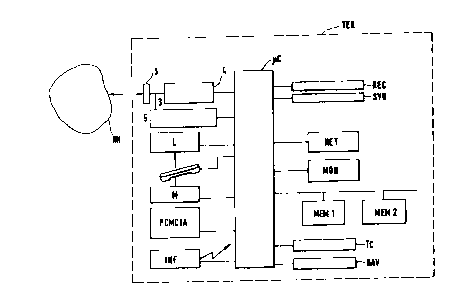Some of the information on this Web page has been provided by external sources. The Government of Canada is not responsible for the accuracy, reliability or currency of the information supplied by external sources. Users wishing to rely upon this information should consult directly with the source of the information. Content provided by external sources is not subject to official languages, privacy and accessibility requirements.
Any discrepancies in the text and image of the Claims and Abstract are due to differing posting times. Text of the Claims and Abstract are posted:
| (12) Patent Application: | (11) CA 2267336 |
|---|---|
| (54) English Title: | TRANSCEIVER FOR VARIOUS INFORMATION FORMATS |
| (54) French Title: | DISPOSITIF POUR RESTITUER ET EMETTRE DES INFORMATIONS DE DIFFERENTS FORMATS |
| Status: | Deemed Abandoned and Beyond the Period of Reinstatement - Pending Response to Notice of Disregarded Communication |
| (51) International Patent Classification (IPC): |
|
|---|---|
| (72) Inventors : |
|
| (73) Owners : |
|
| (71) Applicants : |
|
| (74) Agent: | ROBIC AGENCE PI S.E.C./ROBIC IP AGENCY LP |
| (74) Associate agent: | |
| (45) Issued: | |
| (86) PCT Filing Date: | 1997-07-31 |
| (87) Open to Public Inspection: | 1999-02-11 |
| Availability of licence: | N/A |
| Dedicated to the Public: | N/A |
| (25) Language of filing: | English |
| Patent Cooperation Treaty (PCT): | Yes |
|---|---|
| (86) PCT Filing Number: | PCT/EP1997/004183 |
| (87) International Publication Number: | EP1997004183 |
| (85) National Entry: | 1999-03-24 |
| (30) Application Priority Data: | None |
|---|
The invention relates to a device, for example in the form of a telephone,
capable of transmitting and receiving information in various formats. The
device (TER) has a network interface (NET) for receiving and adapting various
information formats. Language information can optionally be converted into
text information and vice versa. Said device (TER) is capable of transmitting
and receiving both language amd text information.
L'invention concerne un dispositif, par ex. sous forme de téléphone, qui permet d'émettre et de recevoir des informations de différents formats. Ce dispositif (TER) est pourvu d'une passerelle (NET) pour recevoir et adapter des informations de différents formats. A cet effet, un message vocal peut être converti en message textuel et inversement, au choix. Le dispositif (TER) peut émettre et recevoir aussi bien des messages vocaux que des messages textuels.
Note: Claims are shown in the official language in which they were submitted.
Note: Descriptions are shown in the official language in which they were submitted.

2024-08-01:As part of the Next Generation Patents (NGP) transition, the Canadian Patents Database (CPD) now contains a more detailed Event History, which replicates the Event Log of our new back-office solution.
Please note that "Inactive:" events refers to events no longer in use in our new back-office solution.
For a clearer understanding of the status of the application/patent presented on this page, the site Disclaimer , as well as the definitions for Patent , Event History , Maintenance Fee and Payment History should be consulted.
| Description | Date |
|---|---|
| Inactive: IPC expired | 2013-01-01 |
| Inactive: IPC from MCD | 2006-03-12 |
| Inactive: IPC from MCD | 2006-03-12 |
| Inactive: IPC from MCD | 2006-03-12 |
| Time Limit for Reversal Expired | 2003-07-31 |
| Application Not Reinstated by Deadline | 2003-07-31 |
| Inactive: Abandon-RFE+Late fee unpaid-Correspondence sent | 2002-07-31 |
| Deemed Abandoned - Failure to Respond to Maintenance Fee Notice | 2002-07-31 |
| Letter Sent | 1999-09-20 |
| Letter Sent | 1999-09-20 |
| Letter Sent | 1999-08-30 |
| Inactive: Single transfer | 1999-07-20 |
| Amendment Received - Voluntary Amendment | 1999-07-20 |
| Inactive: Cover page published | 1999-06-21 |
| Inactive: IPC assigned | 1999-05-18 |
| Inactive: IPC assigned | 1999-05-18 |
| Inactive: IPC assigned | 1999-05-18 |
| Inactive: First IPC assigned | 1999-05-18 |
| Inactive: Courtesy letter - Evidence | 1999-05-04 |
| Inactive: Notice - National entry - No RFE | 1999-05-03 |
| Application Received - PCT | 1999-04-30 |
| Application Published (Open to Public Inspection) | 1999-02-11 |
| Abandonment Date | Reason | Reinstatement Date |
|---|---|---|
| 2002-07-31 |
The last payment was received on 2001-06-21
Note : If the full payment has not been received on or before the date indicated, a further fee may be required which may be one of the following
Patent fees are adjusted on the 1st of January every year. The amounts above are the current amounts if received by December 31 of the current year.
Please refer to the CIPO
Patent Fees
web page to see all current fee amounts.
| Fee Type | Anniversary Year | Due Date | Paid Date |
|---|---|---|---|
| Basic national fee - standard | 1999-03-24 | ||
| Registration of a document | 1999-03-24 | ||
| MF (application, 2nd anniv.) - standard | 02 | 1999-08-02 | 1999-06-16 |
| Registration of a document | 1999-07-20 | ||
| MF (application, 3rd anniv.) - standard | 03 | 2000-07-31 | 2000-06-20 |
| MF (application, 4th anniv.) - standard | 04 | 2001-07-31 | 2001-06-21 |
Note: Records showing the ownership history in alphabetical order.
| Current Owners on Record |
|---|
| ALCATEL |
| Past Owners on Record |
|---|
| DANIEL LECOMTE |